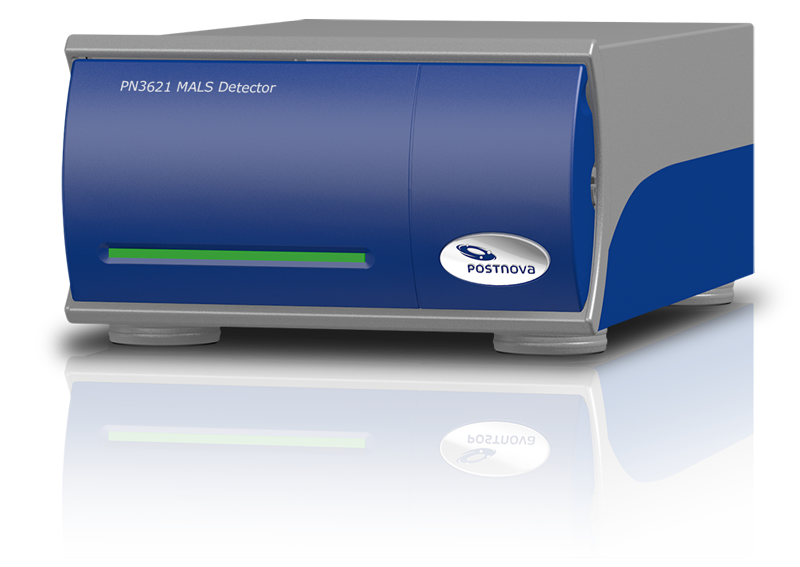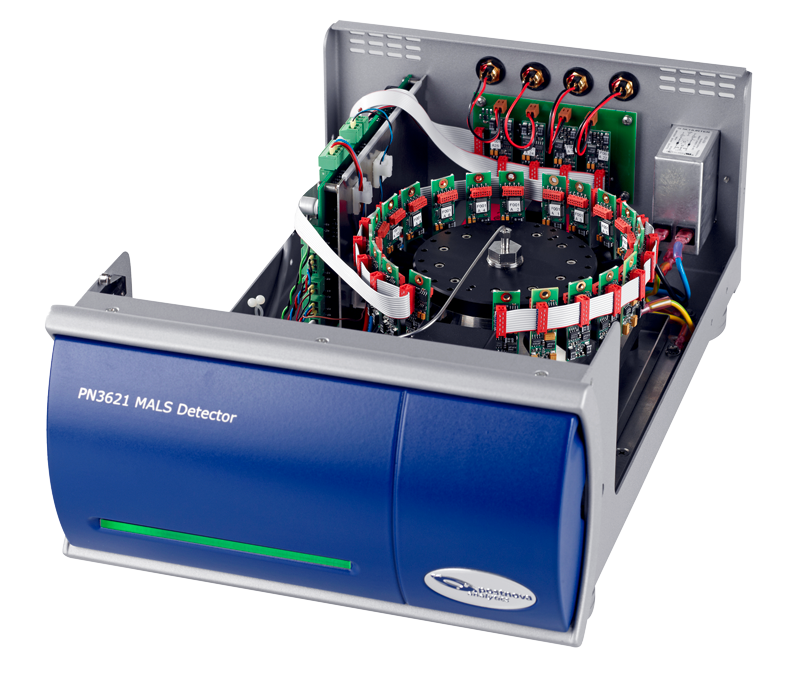PN3621 Multi-Angle Light Scattering Detector
The PN3600 Series of Multi-Angle Light Scattering detectors has been especially developed for coupling with Postnova Field-Flow Fractionation separation systems. The MALS Light Scattering platform consists of different variants offering a flexible solution for all kind of FFF applications. Based on over two decades of practical experience in using and hyphenating FFF and MALS, Postnova offers the most flexible and powerful MALS solution available today. The unique PN3621 MALS is the top model of this PN3600 detector series, meeting the highest requirements in terms of sensitivity, precision and flexibility, and offers unique technical features:
Maximum Number of Angles
The Postnova PN3621 MALS detector system incorporates 21 full working angles available in aqueous and organic solvents. This is the broadest angular range of any commercial light scattering instrument available today. The 21 angles are crucial to fulfill the high requirements set for measuring complex particular samples, ensuring the highest precision in molecular weight and particle size determination. With 21 angles the PN3621 allows to achieve better results by improved data fits and provides the best results in your laboratory, especially for high molar mass polymers, particles and protein aggregates.
Unique Low Angle Range
The precision of molar mass and particle size determination is not only dependent on the total number of angles available, but even more on the number of working low angles which can be used for calculation. Especially angles below 35° are crucial for a correct molar mass and size determination, such as for branched polymers, high molar mass macromolecules, protein aggregates and particles. The Postnova PN3621 MALS meets this standard and offers a complete set of stable working low angles at 7°, 12°, 20° and 28° onwards.
Vertical Flow Cell
MALS is typically being used to measure larger sample species, such as protein aggregates, high molar mass macromolecules and particles. Because of their size and fragile nature these samples need a gentle treatment to avoid any alteration. Potentially shear forces, chain degradation, conformational changes and deterioration or complete loss of bioactivity can be induced by turbulent light scattering flow cells. Also aggregation, adsorption and sedimentation phenomena can cause problems inside a light scattering cell, especially when constructed with internal flow obstacles, edges and dead volumes. The new Postnova PN3621 avoids all this and offers a vertical flow cell where the sample easily can pass through without any alteration.
Advanced Electro Optics
The PN3621 MALS employs the latest opto-electronic and laser designs, including digital signal processing for each of the 21 angles. The electronics is based on a true 24 bit resolution AD system and offers a broad dynamic signal range. For maximum flexibility it is possible to read-in up to 4 external analogue signals. The PN3621 is very compact and light weight with a small footprint, saving limited lab space and allowing a flexible use and transportation to different locations.
Broad Application Range
Because of its unique design, flexibility and advanced performance features, the instrument is ideally suited for the most challenging nano and macro applications from various areas in science:
- Biotechnology: Alginates, Carrageenans, Hyaluronic Acids, Cell Organelles, Exosomes
- Biopharmaceutical: Peptide, Protein, Antibody, Virus Aggregates and Conjugates
- Food and Agro Science: Starches, Pectins, Polysaccharides, Proteins, Casein Micelles
- Polymer Science: Rubbers, Latex Dispersions, Polyolefins, Polyelectrolytes
- Environmental Research: Humic-Fulvic Colloids, Iron Oxides, Clays, Silica Particles
- Nanotechnology: TiO2, CNT, C60, Latex, ZnO Nanoparticles and Silica Nanoparticles



Sample Cell Volume:
63 µL
Pressure Stability:
up to 5 bar
Light Scattering Volume:
< <7.8 nL
Wetted Parts:
Glass, PTFE +25 % carbon, stainless steel, titan
Solvent Compatibility:
Aqueous and organic solvents with the same flow cell
Light Scattering Angles:
7°-164° at 21 Angles
0-10 V at 24 bit
0.6 µV resolution
Signal Processing:
DSP on every single photo detector, different filter algorithms possible
Molar Mass Range:
200 Da to 1012 Da depending on sample and wavelength
Radius of Gyration Range:
Approx. 8 nm to 500 nm depending on sample and wavelength
Laser Specifications:
532 nm (green)
2.5 – 50 mW adjustable other wavelength and filter options available on request
Laser Life Time:
Approx. 10.000 hours
Safety Functions:
Vapor sensor
Leak sensor
Cell Temperature Control:
10°C above room temperature up to 50°C
Stability ± 0.01°C at 35°C
Dimensions:
46 cm x 26 cm x 16 cm
Shipping Weight :
13 kg
Power Requirements:
100 - 240 V, 50/60 Hz, 155 W, Universal power input
Computer Requirements:
Needs a PC/system with a free Ethernet connection or a Ethernet hub for operation!
Electronic Inputs/Outputs:
Error In/Out, Injection Ready
In/Out, Ethernet Interface
Environmental Conditions:
20 – 80 % relative humidity (noncondensing) at an ambient temperature range of 4 – 30°C (when the laser is activated above 10°C)



